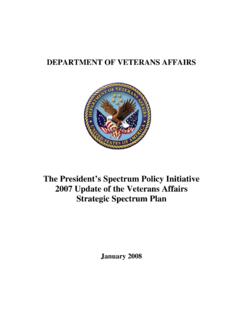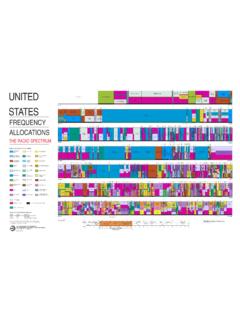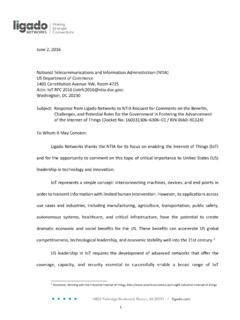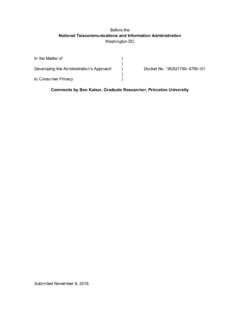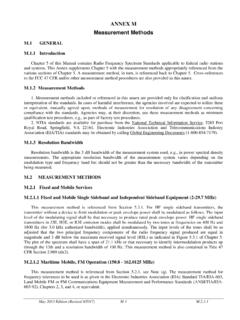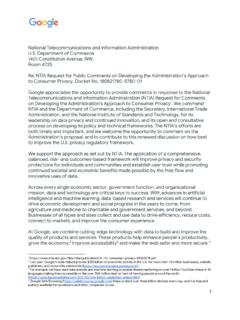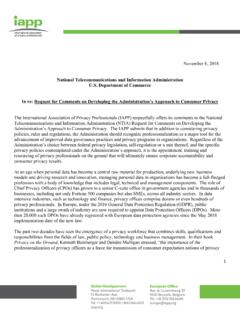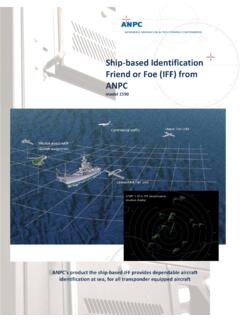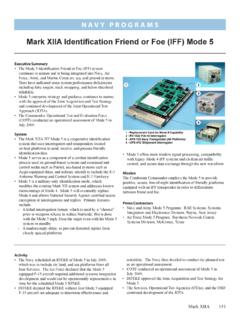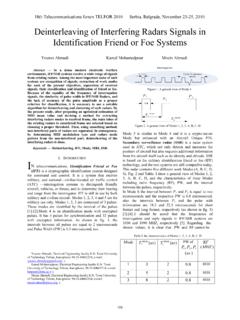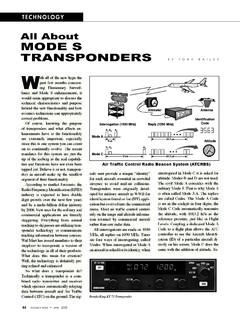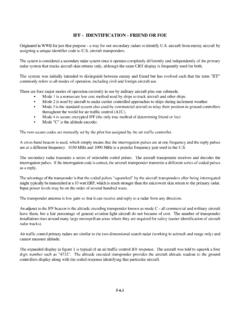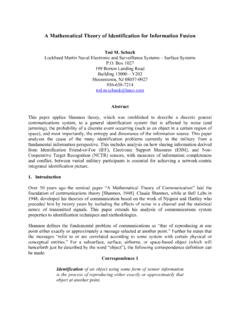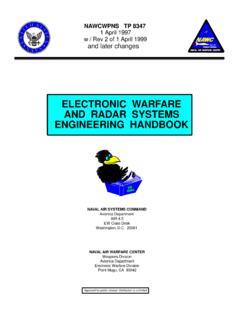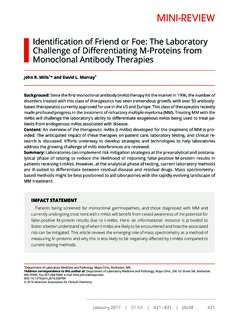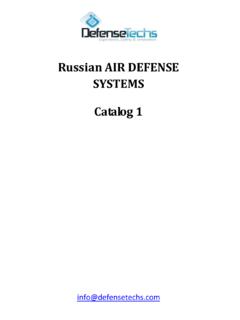Transcription of 960-1164 MHz 1. Band Introduction
1 March 1, 2014 960- 1164 mhz 1 . band Introduction The 960-1164 MHz band is part of the 960-1215 MHz band allocated on a primary basis to the Federal Government for the aeronautical radionavigation service (ARNS). The Federal Aviation Administration (FAA) domestically manages the 960-1164 MHz band . Ground-based and airborne systems that operate in this band control civilian and military aircraft in the National Air Space (NAS). The Distance Measuring Equipment (DME) system and its military version, the Tactical Air Navigation (TACAN) system operates throughout the band . The Air Traffic Control Radar Beacon System (ATCRBS) and the Mode Select (Mode S) system have a ground-based and airborne component and operate on the frequencies of 1030 MHz and 1090 MHz. identification Friend or Foe (IFF) system is the primary positive means of aircraft identification in air defense operations.
2 An IFF transponder receives interrogation pulses at one frequency (1030 MHz), and sends the reply pulses at a different frequency (1090 MHz). Proper use of IFF facilitates rapid engagement of enemy aircraft, conserves air defense assets, and reduces risk to friendly aircraft. The Traffic Alert and Collision Avoidance System (TCAS) operates at 1030 and 1090 MHz and is independent of any ground system. The International Telecommunication Union 2007 World Radiocommunication Conference allocated the band 960-1164 MHz to aeronautical mobile (route) service (AM(R)S).1 The Automatic Dependent Surveillance-Broadcast (ADS-B) system and the Universal Access Transceiver (UAT) operate on the frequencies of 978 MHz and 1090 MHz. In addition to the ARNS and AM(R)S systems, the Department of Defense (DOD) operates a communication system, the Joint Tactical Information Distribution System (JTIDS) in this band on a coordinated basis.
3 1 International Telecommunications Union- Radio Regulation 960-1164 MHz Page 2 of 10 2. Allocations 2a. Allocation Table The frequency allocation table shown below is extracted from the NTIA Manual of Regulations and Procedures for Federal Radio Frequency Management, Chapter 4 Allocations, Allotments and Plans. Table of Frequency Allocations United States Table Federal Table Non-Federal Table FCC Rule Part(s) 960-1164 AERONAUTICAL RADIONAVIGATION US224 US400 Aviation (87) 2b. Additional Allocation Table Information The use of the band 960-1215 MHz by the aeronautical radionavigation service is reserved on a worldwide basis for the operation and development of airborne electronic aids to air navigation and any directly associated ground-based facilities.
4 US224 Federal systems utilizing spread spectrum techniques for terrestrial communication, navigation and identification may be authorized to operate in the band 960-1215 MHz on the condition that harmful interference will not be caused to the aeronautical radionavigation service. These systems will be handled on a case-by-case basis. Such systems shall be subject to a review at the national level for operational requirements and electromagnetic compatibility prior to development, procurement or modification. US400 The use of the center frequency 978 MHz may be authorized to Universal Access Transceiver (UAT) stations on a primary basis for the specific purpose of transmitting datalink information in support of the Automatic Dependent Surveillance Broadcast (ADS-B) Service, Traffic Information Services Broadcast (TIS-B), and Flight Information Broadcast (FIS-B).
5 960-1164 MHz Page 3 of 10 3. Federal Agency Use: 3a. Federal Agency Frequency Assignments Table: The following table identifies the frequency band , type(s) of allocation(s), types of application, and the number of frequency assignments in the Government Master File (GMF) by agency. Federal Frequency Assignment Table AERONAUTICAL RADIONAVIGATIONAIR GROUND AIR OPERATIONSLAND MOBILE OPERATIONSLAND RADIOLOCATIONLAND RADIONAVIGATIONMOBILE RADIOLOCATIONMOBILE RADIONAVIGATIONRESEARCH DEVELOPMENT TESTING EVALUATIONTOTALAF3854983111644220898AR52 215119560253CG50 24864 DHS123 DOE111 3 FAA20881218426243756MC7911 2152109N174254 2922132125538 NASA112 TOTAL283112731531715261944335626 The number of actual systems, or number of equipments, may exceed and sometimes far exceed, the number of frequency assignments in a band .
6 Also, a frequency assignment may represent, a local, state, regional or nationwide authrozation. Therefore, care must be taken in evaluating bands strictly on the basis of assignment counts or percentages of - 1164 MHz BandSHARED BANDAGENCYAERONAUTICAL RADIONAVIGATIONTYPE OF APPLICATION 960-1164 MHz Page 4 of 10 3b. Percentage of Frequency Assignments Chart The following chart displays the percentage of frequency assignments in the GMF for the systems operating in the frequency band MHz. AERONAUTICAL R AD IONAVIGATION - 50%AIR GROUND AIR OPERATIONS - 23%LAND M OB ILE OPER ATIONS - 3%LAND RADIOLOCATION - RADIONAVIGATION - RADIOLOCATION - RADIONAVIGATION - , DEVELOPMENT, TESTING,EVALUATION - 4. Frequency band Analysis By Application The systems operating in this band consists of the aeronautical mobile (route) service (AM(R)S) andaeronautical radionavigation service (ARNS) in the International Radio Regulations (RR).
7 The AM(R)S and ARNS are safety services as defined in the RR, Any radiocommunication service used permanently or temporarily for the safeguarding of human life and property. 4a. Aeronautical Radionavigation Service The ARNS is a radionavigation service intended for the benefit and the safe operation of aircraft. There are numerous types of aeronautical radionavigation systems primarily used to ensure safety of flight and to support precision approach and landing of aircraft. These systems operate throughout the 960-1164 MHz band . 960-1164 MHz Page 5 of 10 4b. Distance Measuring Equipment and Tactical Air Navigation Systems DME and TACAN are very similar in their functional performance. DME systems operate between the bands 962-1213 MHz and are usually co-located with a very high frequency (VHF) Omni-directional Range (VOR) operating in the band 108-118 MHz to provide the distance and azimuth from the aircraft to the DME transmitter.
8 An important requirement is a frequency separation of 63 MHz between the interrogation and the reply frequency. This accommodates the pulse-pair shaping and signal processing bandwidth necessary to achieve individual system integrity. This procedure leaves only 126 possible frequency pairs throughout the band 962-1213 MHz. DME and VOR operate in paired channels so at any given location, both the VOR and DME proposed assignments must pass their channel planning criteria. This puts additional constraints on DME assignments. DME allows aircraft to fly safe, accurate paths during the en-route, terminal, landing, missed approach and departure phases of flight. The system provides aircraft pilots with the slant range to a ground-based transponder station. The ground-based transponder system is air-initiated, with the airborne transmitter interrogating a transponder, and calculating range from the time difference between the initiation of the interrogation and receipt of the reply.
9 The maximum range for high altitude service (18km) is 240 km and for low altitude, service ( km) the distance is 74 km. The maximum range for the standard terminal service is 46 km for an altitude of km. TACAN is a tactical air navigation system for the military services used ashore, afloat, and airborne. TACAN is primarily collocated with the civil VOR stations (VORTAC facilities) to enable military aircraft to operate in the NAS and to provide DME information to civil users. The Navy, Coast Guard, and Military Sealift Command (MSC) operate several hundred sea-based TACAN stations. The FAA operates approximately 60 VOR, 405 VOR/DME, and 590 VORTAC ground stations, as well as another 30 DMEs. Other Federal agencies, state and local governments, and private entities also own some of these facilities.
10 Secondary Surveillance Radar (SSR) and Traffic Alert and Collision Avoidance System (TCAS) Two types of ARNS systems operate at 1030 and 1090 MHz: SSR (which includes ATCRBS and Mode S), and SSR provides cooperative surveillance information 2 RTCA Special Committee 185, Aeronautical Spectrum Planning for 1997 2010, RTCA/DO-237, 27 January 1997. 960-1164 MHz Page 6 of 10 from appropriately equipped aircraft. An SSR can function either as a stand-alone system, or in conjunction with primary long range and terminal surveillance radars. SSR operation requires an uplink interrogation, a reception and response by a cooperative airborne transponder, and reception of the transponder's downlink reply. The transponder's response identifies the aircraft and is ordinarily much stronger than the reflection that the primary surveillance radar receives.
